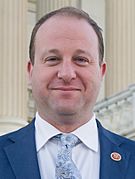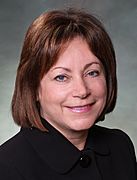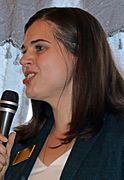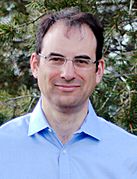Government of Colorado facts for kids
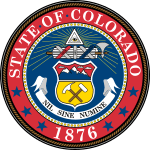
|
|
| Part of | United States of America |
|---|---|
| Constitution | Constitution of Colorado |
| Legislative branch | |
| Name | Legislature |
| Type | Bicameral |
| Meeting place | Colorado State Capitol |
| Upper house | |
| Name | Senate |
| Presiding officer | James Coleman, President |
| Lower house | |
| Name | House of Representatives |
| Presiding officer | Julie McCluskie, Speaker |
| Executive branch | |
| Head of State and Government | |
| Title | Governor |
| Currently | Jared Polis |
| Appointer | Election |
| Cabinet | |
| Name | Cabinet |
| Leader | Governor |
| Deputy leader | Lieutenant Governor |
| Headquarters | State Capitol |
| Judicial branch | |
| Name | Judiciary of Colorado |
| Courts | Courts of Colorado |
| Supreme Court of Colorado | |
| Chief judge | Monica Márquez |
| Seat | Denver |
The Government of Colorado is how the state of Colorado is run. It is set up with three main parts, called "branches." These are the executive branch (led by the Governor), the legislative branch (called the General Assembly), and the judicial branch (which includes the Supreme Court and other courts).
This system was created by the Constitution of the State of Colorado. It also lets people directly participate in making decisions. This is done through things like initiatives (where people propose laws), referendums (where people vote on laws), and recalls (where people can vote to remove an official).
Contents
Executive Branch: Leading the State
The executive branch is in charge of carrying out the laws. It's like the management team for the state.
Top Elected Officials
Colorado has five main officials elected by people across the whole state. They each serve for four years.
-
Jared Polis (D)
Governor -
Dianne Primavera (D)
Lieutenant Governor
The Lieutenant Governor is chosen along with the Governor on the same ballot. This means you vote for both of them at the same time.
Other Elected Executive Roles
Some other important people are also elected to help run the executive branch. These include members of the Colorado State Board of Education. This board helps guide the state's schools.
Also, the Regents of the University of Colorado are elected. They oversee the University of Colorado system. Because these groups are elected, the Governor doesn't directly control the Department of Education or the state's colleges and universities.
Main State Departments
The executive branch also includes many departments. These departments handle different areas of state government. They help provide services and enforce laws. Some examples include:
- Department of Agriculture (CDA) - Helps farmers and ranchers.
- Department of Corrections (CDOC) - Manages prisons.
- Department of Early Childhood (CDEC) - Focuses on young children.
- Department of Education (CDE) - Oversees public schools.
- Department of Health Care Policy and Financing (HCPF) - Manages health care programs.
- Department of Higher Education (CDHE) - Supports colleges and universities.
- Department of Human Services (CDHS) - Provides social services.
- Department of Labor and Employment (CDLE) - Helps with jobs and worker rights.
- Department of Law (DOL) - Provides legal services for the state.
- Department of Local Affairs (DOLA) - Helps local governments.
- Department of Military and Veterans Affairs (DMVA) - Supports military members and veterans.
- Department of Natural Resources (CDNR) - Manages state parks and wildlife.
- Department of Personnel and Administration (DPA) - Manages state employees.
- Department of Public Health and Environment (CDPHE) - Protects public health and the environment.
- Department of Public Safety (CDPS) - Includes the State Patrol and other safety agencies.
- Department of Regulatory Agencies (DORA) - Licenses professionals and businesses.
- Department of Revenue (DOR) - Collects taxes.
- Department of State (DOS) - Handles elections and business filings.
- Department of Transportation (CDOT) - Builds and maintains roads.
- Department of the Treasury (CDT) - Manages state money.
Legislative Branch: Making Laws
The legislative branch is called the Colorado General Assembly. Its main job is to create laws for the state. It has two parts, like two houses: the House of Representatives and the Colorado Senate.
Members of the House of Representatives serve for two years. They are elected from specific areas, called districts, that have about the same number of people. The House has 65 members.
Members of the State Senate serve for four years. About half of the Senate members are elected every two years. They are also elected from districts with similar populations. The Senate has 35 members. In total, Colorado has 100 state lawmakers.
Direct Democracy: People Power
Colorado's government allows its citizens to have a direct say in how the state is run. Besides just voting for officials, people can also:
- Start new laws themselves (called an initiative).
- Vote on laws that the General Assembly has passed (called a referendum).
- Vote to remove elected officials from office before their term ends (called a recall).
Judicial Branch: Interpreting Laws
The judicial branch is the court system of Colorado. Its job is to interpret the laws and make sure they are followed fairly. The head of the state's court system is the Chief Justice of the Colorado Supreme Court.
Colorado has several types of courts:
- The Colorado Supreme Court is the highest court in the state.
- The Colorado Court of Appeals reviews decisions from lower courts.
- Colorado district courts handle serious cases.
- Colorado county courts handle less serious cases.
- Colorado water courts deal with water rights.
- Colorado municipal courts handle local city laws.
Most of these courts are part of the state's court system. However, in the city of Denver, some courts like the county and municipal courts are managed differently.
Most crimes in Colorado are handled by a district attorney. One district attorney is elected for each of the state's 22 judicial areas. The state attorney general can also prosecute some crimes. For local city law violations, city attorneys handle the cases.
Local Government: Running Communities
Colorado is divided into 64 counties. Counties are important because Colorado doesn't have smaller divisions like townships. Two counties, the City and County of Denver and the City and County of Broomfield, are special because their city and county governments are combined.
Colorado also has 273 municipalities, which are cities and towns. These communities operate under different rules:
- Two are combined city and county governments (Broomfield and Denver).
- Many are "home rule" municipalities, meaning they have more freedom to create their own local laws.
- Others are "statutory" cities or towns, which follow state laws more closely.
- One, Georgetown, has a special "territorial charter."
A city or town can sometimes extend into more than one county. Besides counties and municipalities, there are also over 4,000 special districts. These districts provide specific services like water, fire protection, or parks.
Other Governments
Colorado is also home to two federally recognized tribes: the Southern Ute Indian Tribe and the Ute Mountain Ute Tribe. These tribes have their own governments.
Images for kids
See also
- Elections in Colorado
- Law of Colorado
- Politics of Colorado
- Bibliography of Colorado
- Geography of Colorado
- History of Colorado
- Index of Colorado-related articles
- List of Colorado-related lists
- Outline of Colorado


